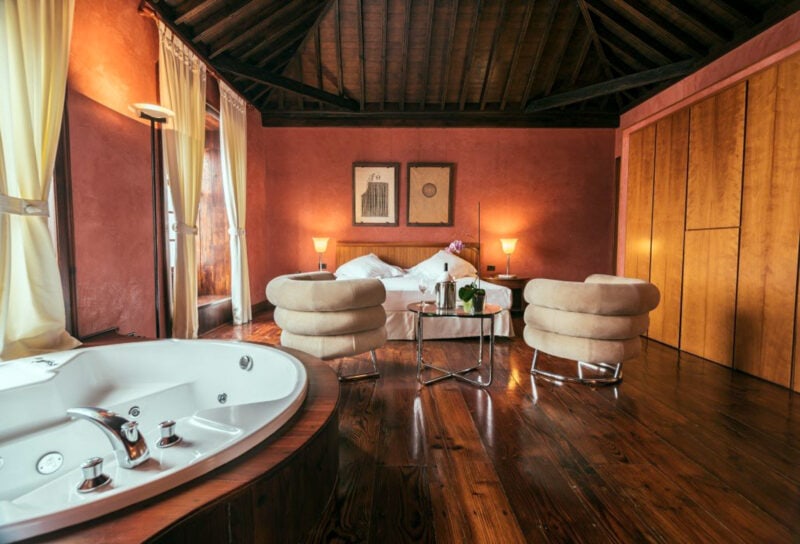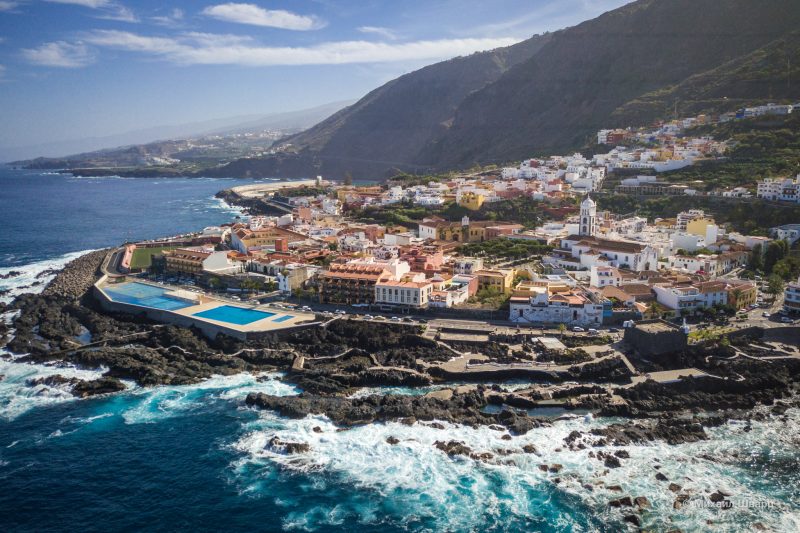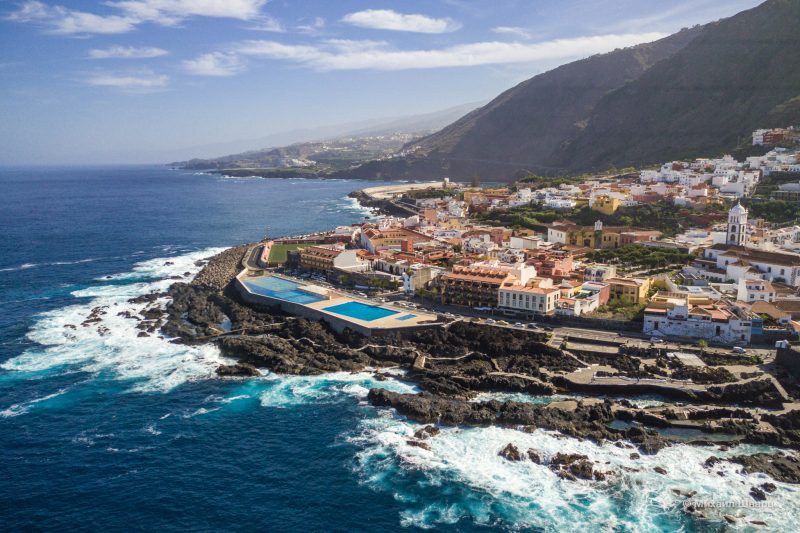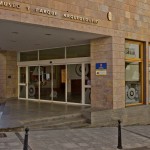
In the north of Tenerife island lies the small but very cozy town of Garachico, whose character is more reminiscent of a continental Spanish town. It stretches from the northwestern slopes of the Pico Viejo stratovolcano (Pico Viejo, meaning “old peak”) to the ocean. Pico Viejo (3,135 meters) is the second highest peak in the Canary Islands after the Teide volcano, and it is part of the Teide National Park. The distance from Garachico to the island’s capital, Santa Cruz de Tenerife, is 60 km.
The town deserves the attention of tourists. It is interesting for its tragic history and for being built among solidified volcanic lava. Its jagged coastline, made up of volcanic rock debris, lends the town a certain charm.





The municipality of Garachico owns part of the protected natural areas of the Teide National Park (Parque nacional del Teide), the Corona Forestal Natural Park (Parque Natural de la Corona Forestal), the Chinyero Nature Reserve (Reserva Natural Especial del Chinyero), the La Culata Cliffs Protected Landscape (Paisaje Protegido de los Acantilados de La Culata), the Interián Site of Scientific Interest (Sitio de Interés Científico de Interián), and the Roque de Garachico Natural Monument (Monumento Natural del Roque de Garachico). All of these spaces are included in the Natura 2000 network as Special Areas of Conservation.
Hotels in Garachico
Hotel LIVVO La Quinta Roja ⭐️⭐️⭐️⭐️

The LIVVO La Quinta Roja Hotel is located in the historic center of the town, just 50 meters from the natural pools on the coast. It occupies a restored 16th-century colonial-style mansion with an interior courtyard. The continental breakfasts are hearty and varied, with freshly squeezed juices, local cheeses, and meats.
Hotel San Roque ⭐️⭐️⭐️⭐️

San Roque is an adult-only boutique hotel with an eye-catching, vibrant design. It is housed in an 18th-century building with ocean views from the windows. All rooms have a hydromassage bathtub. The restaurant by the pool serves Canarian and Mediterranean dishes. The beach is just a 5-minute walk away. There is an outdoor pool and terrace.
Isla Baja Suites ⭐️⭐️⭐️⭐️

Isla Baja Suites is a Canarian-style hotel located in an 18th-century building. Its elegant suites are equipped with a kitchenette. Many rooms offer ocean views. The natural pool is just 250 meters away. The hotel is ideal for family vacations.
Garahote ⭐️⭐️⭐️

Garahote is located on the ocean shore in an 18th-century house with an interior courtyard. The natural pool is just 50 meters away. The rooftop terrace offers beautiful views. The cozy rooms are decorated in Canarian and modern styles.
Trevejo Hostel

Trevejo is a youth hostel in the city center. There is a supermarket nearby. The hostel is clean and comfortable, with a large kitchen, bathrooms, good internet, a washing machine, and places to socialize. The beach is 400 meters away.
The Past of Garachico

Until the 15th century, the land where the town is now located was inhabited by the Guanches. After the conquest of Tenerife by the Spaniards, the Genoese banker Cristóbal de Ponte built the town of Garachico here. The year 1496 is considered the founding year of Garachico.
Garachico was one of the wealthiest towns in Tenerife, serving as its main seaport. Ships loaded local produce and Malvasia wine at the port, and unloaded goods from Europe, America, and Asia. The town developed rapidly, with streets and plazas, residential buildings, hospitals, churches, and convents being constructed. The local residents were considered the wealthiest on the island.
But trouble came from where they didn’t expect it. In 1601, trading ships brought the plague from the mainland. Within 5 years, the city’s population decreased by a third. In 1646, a landslide struck the city. As a result, 100 people died, and 40 ships sank. And on May 5, 1706, the most terrifying event in Garachico’s history occurred – the eruption of the Trevejo volcano. At dawn, seven lava flows began descending from the mountain. Along the way, they destroyed most of the city, including the port. But despite everything, there were no casualties. The population was evacuated in time. All that remained of the once-prosperous city were memories and a few miraculously surviving buildings. Traces of that eruption can still be seen today on the La Culata cliff.
After the natural disaster, merchants started using the port of Puerto de la Cruz, while Garachico gradually recovered and became a small fishing port. Throughout the 18th century, a new town was built directly on the solidified lava, preserving the architectural values of the previous buildings. In 1980, in gratitude for caring for nature and preserving cultural heritage, King Juan Carlos I awarded Garachico the Gold Medal of Fine Arts.
Attractions
Roque de Garachico Rock
Plaza de la Libertad
Church of Santa Ana
Monastery of San Francisco
Fortress of San Miguel
Monastery of Santo Domingo
Hermitage of San Roque
Franciscan Monastery
Mill
Puerta de Tierra Park
El Caletón Natural Pools
Door Without Door Sculpture
Wine Riot Monument
Mirador de Garachico
Mirador de Atalaya
Mirador del Emigrante
Mirador El Guincho
Le Patissier Cafe
La Alsaciana Heladería Pastelería
It seems that time has stood still in Garachico. The town has many historical buildings from the 18th century. They have all been restored and have information plaques on their facades. The smooth terracotta-colored walls of the mainly two-story houses and narrow cobbled streets look romantic. Even the souvenir shops do not stand out from the overall style.
Roque de Garachico / Roque de Garachico Island

About 300 m from the shore, a rock emerges from the water. This is the Roque de Garachico (Monumento natural del Roque de Garachico) – the main attraction and hallmark of the town. The vegetation on the island is sparse. Some migratory and endangered bird species such as Bulwer’s petrels, shearwaters, and storm petrels nest here. (Coordinates on Google Maps).
Plaza de Libertad / Plaza de Libertad

The town’s main square is called Plaza de Libertad (coordinates on Google Maps). Here you’ll see a park, the Church of Santa Ana, the interesting “Stone House” (Casa de Piedra) built in the 16th-17th centuries, as well as a monument to Simón Bolívar – the leader in the war for independence of the Spanish colonies in America, who had Guanche (the ancient inhabitants of Tenerife) blood. It’s pleasant to sit in the shade of the trees at the Libertad café, sipping coffee to the sound of chirping canaries and the ringing of church bells.
Church of Santa Ana / Iglesia de Santa Ana

One of the most beautiful and richest churches in the northern part of Tenerife is the Church of Santa Ana (Iglesia de Santa Ana), which was built in 1520 (coordinates on Google Maps). The bell tower was added later. During the volcanic eruption, the building was severely damaged, but by 1721 it was restored to its original appearance.
The interior of the church is quite lavish: coffered ceilings in the Mudéjar style, several chapels with Baroque altars, an image of Christ of Mercy dating from the 16th century, and a 17th-century marble baptismal font. The church also has a museum of sacred art.
Monastery of San Francisco / Ex-Convento de San Francisco

The Monastery of San Francisco (Ex-Convento de San Francisco) was founded in 1524 (coordinates on Google Maps). In 1706, the building was destroyed by a volcano but was later restored. Now you can see a two-story, bright sandy-colored building with two entrance groups. In the inner courtyard, in the middle of the paved area, there are several rectangular lawns with evergreen conifers planted in the center. A wooden terrace runs along the second floor. The interior spaces are also decorated with wood.
Currently, the former monastery houses the House of Culture. It contains a public library, a city archive, and permanent exhibitions on “The Canary Islands, Volcanoes in the Ocean,” “Exhibition of Old Photographs of Garachico,” and “Collection of Shells, Fossils, Minerals and Rocks.”
Castillo de San Miguel / Castillo de San Miguel

The small defensive fortress of San Miguel (Castillo de San Miguel) was built by royal decree of Philip II on the ocean shore in 1575-1577 to protect the port of Garachico from pirate raids (coordinates on Google Maps). During the volcanic eruption, the fortress was slightly damaged and quickly restored. Since 1985, San Miguel has been a cultural heritage site and belongs to the city. Inside, you’ll find a historical museum, an information center, and an exhibition hall. You can also climb the stairs and see the cannons.
Monastery of Santo Domingo / Convento Santo Domingo

The Saint Dominic Monastery (Antiguo Convento Santo Domingo de Guzmán) in Garachico was founded in the 17th century. It is one of the most beautiful monasteries on Tenerife. The building is two-story, with arched entrance portals, part of the facade is decorated with volcanic stone, and there is a bell tower. The 7 wooden balconies are made in the Portuguese style (coordinates on Google Maps). In the fateful year of 1706, Santo Domingo was almost unharmed. After recent restoration, a nursing home residence Nuestra Señora de la Concepción (Residencia De Ancianos Nuestra Sra. de la Concepción), a municipal auditorium for 300 people, and the Museum of Contemporary Art with a permanent exhibition were opened in the former monastery.
The monastery building faces Santo Domingo Square (Plaza de Santo Domingo). It is a quiet, beautiful square in the form of a park with tall trees and a fountain in the center. A place for rest and solitude.
Saint Roch’s Hermitage / Ermita de San Roque

Saint Roch’s Hermitage (Ermita de San Roque) is a small temple built in the Canarian architectural style. It is located at the entrance to the town of Garachico (coordinates on Google Maps). The hermitage was built in 1603 so that parishioners could pray for the end of the plague that was raging on the Canary Islands at that time. It is consecrated in honor of Saint Roch, the protector from epidemics and calamities. Every year on August 16, the islanders hold a grand pilgrimage in his honor.
The San Roque Hermitage is a rectangular building with a hipped roof and two bell towers on either side of the entrance. The main portal is framed by a semicircular stone arch. On the altar is a sculpture of Saint Roch.
Franciscan Monastery / Convento de concepcionistas franciscanas

The Franciscan Conceptualist Monastery (Convento de concepcionistas franciscanas) was established in 1643. In 1706, the building was damaged by an eruption, three years later by a fire, and in 1856 by a flood. But despite all the misfortunes, the monastery has survived to this day and is now the only active monastery in Garachico. Its simple white facade features a stone portal and heraldic reliefs. The doors and narrow windows are trimmed in wood. Inside, the altar with the image of the Immaculate Conception of the Virgin (Nuestra Señora de la Concepción) catches the eye. (Coordinates on Google Maps).
Mill / Casa El Molino

In Garachico, a mill (Casa El Molino) has been preserved, whose millstones were driven by the force of water flowing down from the mountains through special channels. The building lost its significance in the 19th century, but the City Council preserved it. Now there is an exhibition inside telling about the volcanic activity of the municipality. Due to active urban development, the mill ended up lower than the street level, so it is not easily visible. (Coordinates on Google Maps).
Puerta de Tierra Park / Parque de la Puerta de Tierra

The historic Puerta de Tierra Park (Parque de la Puerta de Tierra) takes visitors back in time (coordinates on Google Maps). In the green area adjacent to Juan González de la Torre Square, there are arched gates to the old port of Garachico, dated to the 16th century. On the grounds of the park, there is an old wine press brought from the San Juan Degollado estate, a monument to the city’s founder Cristóbal de Ponte, and a bust of Rafael Alberti – a poet and playwright who visited the town in 1991.
El Caletón Natural Pools / Piscinas Naturales de El Caletón




There are no beaches in Garachico, except for a tiny city beach and a municipal swimming pool. But there are natural lava pools, formed where two elements met: lava and ocean. Local residents and tourists enjoy swimming in them.
In the natural pools of El Caletón (Piscinas Naturales de El Caletón), each pool is separated from the ocean by rocky natural walls, and the water in them is clean and clear (coordinates on Google Maps). Despite the large waves, swimming here is safe.
Near the natural pools, there are almost no flat areas for sunbathing. For the comfort of visitors, such places were made specifically. And for convenience to walk and descend into the water, they built stairs with handrails. Near the pools, there is a parking lot, shops, a restaurant, and bars.
In the municipality, there is another natural pool called Charco de Los Frailes. But currently, it is closed due to the threat of landslides.
The Door Without Door / Tensei Tenmoku Sculpture

The “Tensei Tenmoku” or “Door Without Door” composition, made of white marble, is the creation of the Japanese sculptor Kan Yasuda, which appeared on the breakwater of the fishing port in 2000 (coordinates on Google Maps). The sculpture is executed in a minimalist style and consists of two parts arranged along an imaginary line. This creates an amazing contrast with the urban and marine landscapes and, at the same time, integrates into the surrounding environment. The “Door Without Door” will make for excellent souvenir photos of Garachico.
The Wine Riot / Motín del vino Monument

The “Wine Riot” (Motín del vino) sculpture immortalized the memory of the struggle of Canarian wine producers against the English monopoly. In the 17th century, this confrontation ended with the victory of the Canarians. They managed to defend their right to supply their wine to Europe.
The “Wine Riot” work was commissioned from the sculptor Luis Montul. The five-meter sculpture of a peasant winegrower in loose clothes and with a small barrel of wine in his hands is made of white Carrara marble. To complete the ensemble, the sculptor used solidified volcanic lava. (Coordinates on Google Maps).
Viewpoints
A beautiful panorama of the city opens up from special viewpoints. Some can be reached on foot, while others require a car.
Mirador de Garachico

The viewpoint is located near the TF-82 highway. From here, you can see a panorama of the city with its houses and streets, as well as the rugged coastline. Nearby is a restaurant of the same name, which is famous for its authentic cuisine and signature olive oil. (Coordinates on Google Maps).
Mirador de Atalaya

From this viewpoint, you can see the city, the island of Roque de Garachico, and the northern coast. To the right, you can see Icod de los Vinos, and to the left, Buenavista del Norte. There is a railing along the edge of the platform. Nearby, there is a parking lot, a souvenir shop, and a small restaurant. (Coordinates on Google Maps).
Mirador del Emigrante

At this viewpoint, there is a monument dedicated to emigrants who left the island for various reasons. The author of the work is the poet and sculptor Fernando Garcia Ramos. On the edge of the cliff stands a man, with one foot stepping into the ocean abyss, behind him scattered suitcases, and instead of a heart, he has a large hole… The inner message of the work is that Tenerife forever remains in the memory and heart. (Coordinates on Google Maps).
Mirador El Guincho

From the rocky outcrop of this viewpoint, you can admire the panorama of the city, the Atlantic Ocean, the El Guincho rocks, a small port, and banana plantations. (Coordinates on Google Maps).
Restaurants and Cafes

Le Patissier – a cafe located inside the Isla Baja Suites hotel. A cozy cafe in an old courtyard. The desserts look beautiful but are not outstanding. By the way, the hotel itself is very good.

The Alsatian Ice Cream Pastry Shop – they sell delicious ice cream here. Buy some to go and head to the promenade.
- Гарачико
- Garachico
- Адрес: Санта-Крус-де-Тенерифе Испания
- GPS: 28,373198 -16,764546










